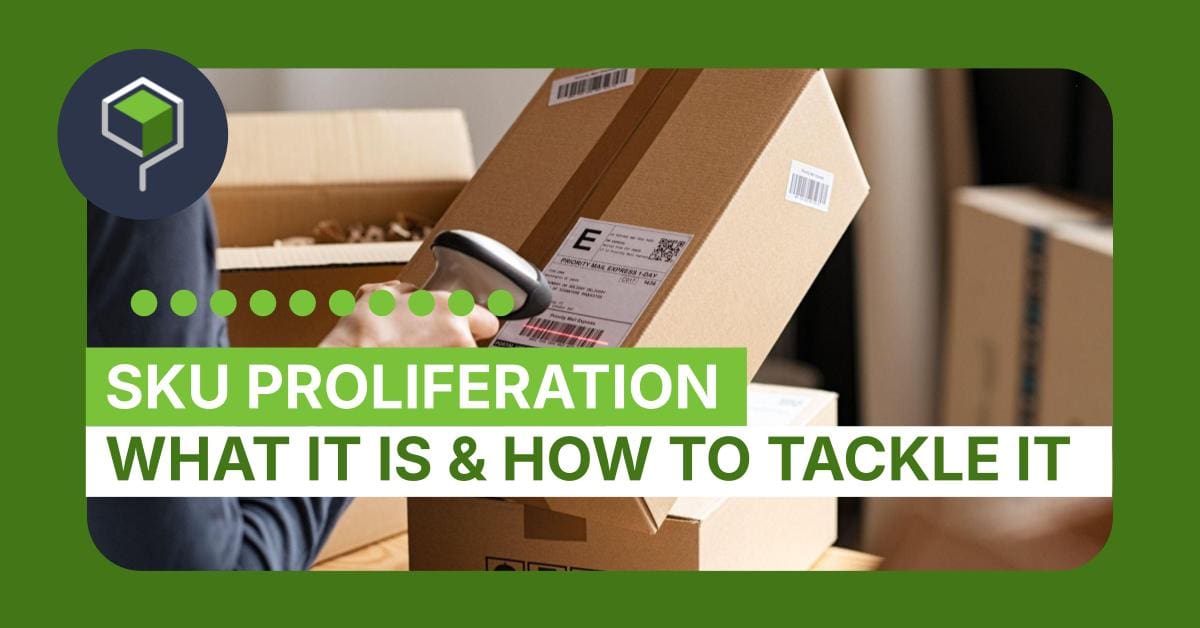
How many SKUs is too many?
This is a tough question to answer in ecommerce, as different product categories have diverse characteristics and associated shopping behaviors. This is what shapes the number of SKUs needed to attract customers and ensure healthy levels of demand.
But while a diverse and dynamic SKU base can drive profitability and marketing opportunities for ecommerce brands, unchecked growth can lead not only to operational inefficiencies, but much higher running costs and even lost sales volume.
So, how do you know when SKU proliferation has crossed the line from aiding your business to hurting it?
In this blog, we’re going to dive into all things SKU proliferation and how to identify when SKU growth is becoming a problem for your business – and how a 3PL partner can help to keep this in check!
What is SKU proliferation?
SKU proliferation occurs when the number of Stock Keeping Units (SKUs) that comprise a business’s inventory expands significantly over time. A business’s SKU count will naturally increase as new products are added to their lineup, increase product variations such as new sizes or colors, or introduce customization options for certain product lines.
It’s important to note that SKU proliferation isn’t necessarily a bad thing in ecommerce; more SKUs help a brand attract different groups of customers and increase sales by offering more choices, which in turn increases profitability.
While keeping a tight rein on your SKU base does make inventory management easier, this will likely stifle business growth in the long run. Consumers want to be excited and intrigued by fresh product lines and the chance to embrace new trends – something which is difficult to do if you keep selling the SKUs over and over with no variation.
However, too many SKUs and too much variation can start to cause problems for your operation. The more stock keeping units you have, the harder it is for your inventory management system to keep track of everything in your warehouse. If SKU proliferation is left unchecked, operational efficiency can take a serious hit – not to mention supply chain efficiency and inventory carrying costs.
What is considered a ‘good’ SKU count?
It’s very difficult to put a number on when SKU growth becomes unmanageable for a business. Some verticals, like apparel and footwear, feature extremely high SKU counts because every product carries a large number of variations for color and size. While rationalizing SKUs to reduce SKU count might make SKU management easier, you risk losing customers if you end up getting rid of comprehensive size ranges or reducing color selections.
However in other categories, carrying too many separate product lines can become confusing for your customer, especially if you are expanding product breadth without considering its relevance to your specific product category.
Why does SKU proliferation happen?
Trying to keep pace with customer demand
ecommerce is an intensely competitive space, especially for verticals like apparel, footwear, and accessories. These industries are also some of the most prone to short-lived trends and seasonal changes, which force brands to constantly bring in new product lines or styles to keep pace with customer expectations. While capitalizing on emerging trends can be a great way to increase sales, there is a risk of SKUs proliferating beyond what your operation can manage.
Targeting regional markets
Expanding into new regions or targeting diverse customer segments can make it necessary to introduce more localized inventory assortments to cater to different preferences. For example, if you’re a fashion brand, the winter apparel that’s going to perform well in Florida is going to be very different than New York. While introducing more product variants to cater to different customer needs is often necessary, the resulting increase in the number of SKUs in your system needs to be approached carefully.
Not tracking key inventory metrics
If your business is not consistently tracking key inventory metrics, such as SKU performance, inventory turnover, or days on hand, it’s much more challenging to identify underperforming SKUs that are taking up warehouse space and ration your SKU portfolio accordingly. Over time, this can lead to businesses retaining more SKUs and continuing to add to their SKU count with new products, causing SKUs to proliferate.
4 Signs that SKU proliferation is a growing problem at your business
Your storage costs are spiraling
The more SKUs you have, the more space your operation will require to store them in advance of picking and order fulfillment. The extent of this problem will depend on the type of products you sell, as smaller, less bulky products have better storage efficiency. However, rampant SKU growth will ultimately force your business to lease more warehouse space–or even move to another logistics provider.
Paying for additional storage capacity isn’t necessarily a major problem–so long as the existing inventory you are storing is actually selling.
Paying to store slow-moving inventory–or even dead stock that’s stopped moving altogether–is very damaging to your business’s bottom line. As well as seeing no return on this additional investment in your fulfillment operation, you’re taking away valuable storage space from popular SKUs that are performing well in favor of slow-moving SKUs that aren’t contributing to your sales volume.
When your storage system has become oriented towards the needs of slower-moving SKUs, rather than newer inventory that is popular with more customers, it’s a clear sign that you need to review your SKU base.
You’re tying up increased amounts of capital
Every time you order a new shipment of inventory or sign a replenishment order, that’s capital that your business is tying up in your inventory. This is certainly worth the investment if more SKUs result in increased sales or attract new customers. But if more capital is getting caught up in slow-moving items that aren’t selling as quickly, there is a risk of lower revenue generation that results in financial losses. There are significant opportunity costs to SKU proliferation, as that money could have been invested in other income-generating activities, like marketing or growth initiatives that help to increase sales volume or brand awareness.
Accumulating excess or unsellable inventory
If a product doesn’t end up performing as well as demand forecasting suggested, your business is left with several SKU variants representing different sizes or colors available. Even if SKU performance is robust, it’s still possible to end up with excess units if the quantity ordered does not align with the seasonal demand for that product. This only has to happen with a few different products for a business to end up accumulating a lot of excess inventory, composed of slow-moving stock or items that have stopped moving altogether.
There are several strategies at a business’s disposal to handle excess stock, including flash sale events, bundling with more popular items, or donations. However, your business is not going to escape a hit to its bottom line.
If you’re finding yourself with more and more non-moving SKUs that aren’t resonating with your customer base, it’s a clear sign that you need some robust SKU analysis to understand what SKUs your business could best do without.
Inventory management is growing more cumbersome
Even with streamlined inventory management software, uncontrolled SKU proliferation will make inventory control and managing pick locations more challenging. If your business is consistently adding new SKUs without making a plan for how to manage or phase out older inventory, it’s going to take a lot more resources to coordinate replenishment and inventory planning effectively. When manual inventory counts roll around, the labor and operating costs of this process are going to be higher because of the number of SKUs present.
Moreover, the order fulfillment process itself can slow down if warehouse staff are struggling to find the right SKUs within your warehouse, as well as increasing the risk of order errors which damage customer satisfaction. If you have multiple locations for fulfillment, these stresses are magnified even further.
So, if your business needs to dedicate more time and resources to SKU management, rather than other facets of fulfillment efficiency, it’s time to take a close look at SKU growth.
How productive 3PL partnerships keep your SKUs in check
High-powered inventory management software
A tech-enabled 3PL will be able to equip with a streamlined inventory management system that makes it much easier to both keep track of SKUs and assess poor inventory lifecycle management. This makes it possible more accurately analyze SKU performance, identify items that are slow-moving or obsolete, and optimize your inventory levels to meet customer demand without ending up with excess inventory.
More effective SKU rationalization
If the time has come to start culling unproductive SKUs from your inventory, having a partner who can take charge of this process and make data-backed recommendations is invaluable, rather than simply using guesswork to decide which SKUs to remove. Plus, the scalability of outsourced fulfillment operations means that your business doesn’t need to worry about paying for warehouse space or labor that you no longer need following SKU rationalization; your SKU portfolio will simply lead the way in making operational changes as needed.
Continuous improvement
As technological advances continue to sweep the logistics industry, a 3PL partner who is committed to staying ahead of industry trends and fresh inventory management strategies is the best pathway to keeping SKUs under control. A productive partnership between your business and an ecommerce fulfillment provider means you can keep identifying opportunities for SKU rationalization and better supply chain management that keep your operation lean and responsive to changes in customer demand.
Looking to manage your SKUs more effectively? Contact ShippingTree today to find out how you can start minimizing logistics costs and streamlining operations.



